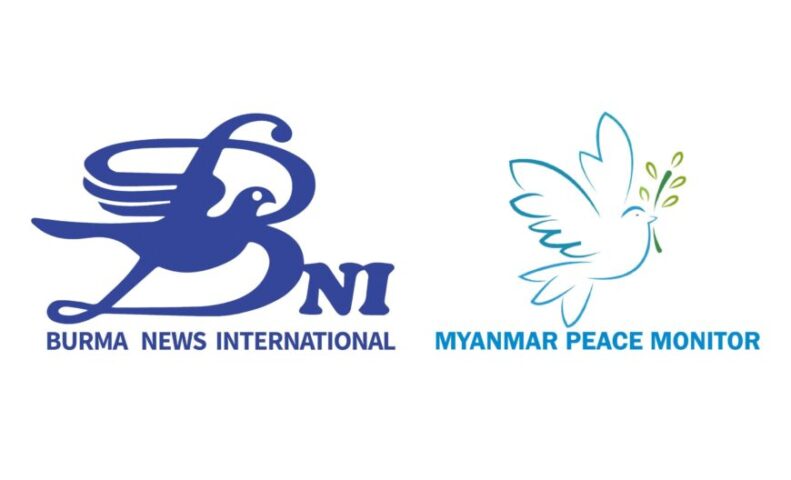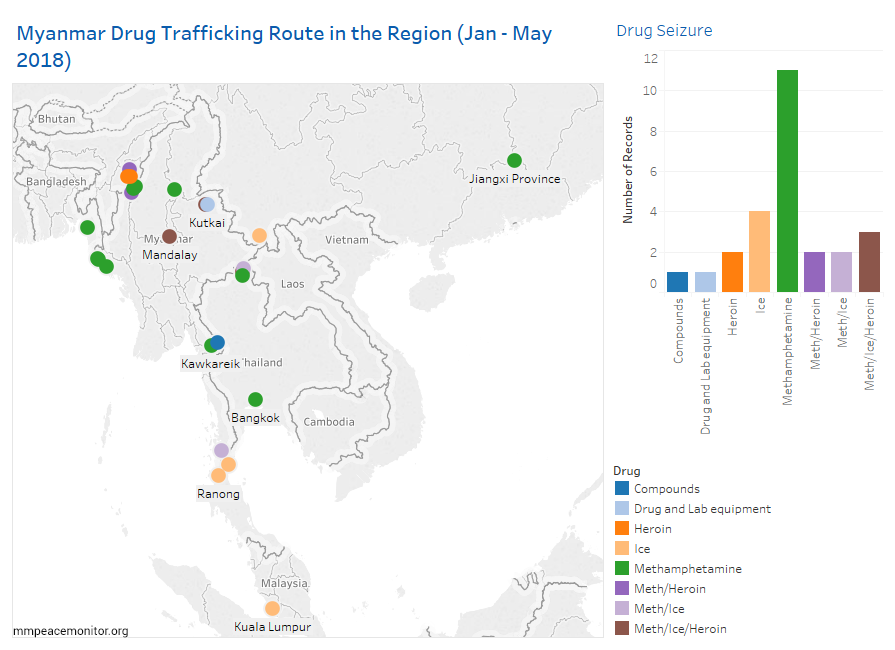Chiang Mai – Though Myanmar peace process has been delayed due to various factors, drug trade in the region is getting increased. “Methamphetamine and heroin are currently estimated to be worth US $40 billion in the regional drug market,” remarked UNODC Advisor Tao Zhiqiang.
Only a few months in 2018, seizure of drugs exceeded than 2017 totals according to UNODC statistics. Since the early 2018, seizure of Myanmar’s drug in neighbouring countries including China, Thailand, Bangladesh and India has been increased. Malaysia made $18 million worth its largest seizure of Ice recently.
Myanmar Peace Monitor Infographic data presents seizures of Methamphetamine is the highest among illicit drug trade followed by Crystal Methamphetamine called Ice and Heroin.
The MPM dashboard has shown that there is little progress on peace process while more conflicts have been broking out in Shan, Kachin, Karen, Chin and Rakhine State. The MPM Infographic shows that conflicts and drug trade are connected as drug trafficking has been growing along the conflict-ridden area. Since early 2018, conflicts among Myanmar military and ethnic armed groups have been resumed.
Narcotics control officials from Bangladesh say various Myanmar separatist groups produce yaba at 37 factories located in the Shan state – which shares borders with China, Laos, and Thailand – and smuggle them to different countries to raise funds. Myanmar military discovered drug labs during the raid in the conflict area in northern Shan State in February.
Opium and heroin production have recently declined, while organized crime have intensified production and trafficking of both low grade yaba methamphetamine and high purity crystal methamphetamine to alarming levels.[1]
Illicit drugs from Myanmar go beyond its neighbouring countries and reach from regional to global. The NZ Herald Newspaper reported “high-purity crystal methamphetamine (from Myanmar) at unprecedented levels, which top drug experts say is appearing on New Zealand streets”.
Some methamphetamine is manufactured in small, mobile facilities, primarily in territories controlled by active or former ethnic insurgent groups. Although no large-scale methamphetamine laboratory seizures have been reported by the Government, the large amounts of methamphetamine seized in Myanmar and neighbouring countries may be indicative of the existence of manufacturing facilities in Myanmar.[2]
Myanmar continues to be a major source of methamphetamine in both tablet and crystalline form, opium and heroin in South-East Asia. The majority of methamphetamine is manufactured in Shan State in the eastern part of the country, and significant amounts originating from the country continue to beseized in neighbouring countries.[3]
The context of illicit crop cultivation, Myanmar remains the country with the largest cultivating areas of opium poppy in Southeast Asia and the second largest in the world after Afghanistan. Cultivation and production predominantly take place in the mountainous areas of Myanmar, often still burdened by ethnic and/or political conflict.[4]
In regards to current drug trends, particularly methamphetamine (both in crystal and pill form) has become increasingly accessible and affordable throughout Asia, reflecting the trend of rising use of amphetamine-type stimulants (ATS) in the region. [5]
[1] UNODC. (n.d.). Retrieved from unodc.org: https://www.unodc.org/southeastasiaandpacific/en/myanmar/2018/05/mekong-region-drug-conference/story.html
[2] UNODC. (June 2017). The Challenge of Synthetic Drugs in East and South-East Asia. UNODC.
[3] National Narcotics Control Commission (NNCC), Ministry of Public Security, China, “Annual Report on Drug Situation in China 2014”, June 2015; Office of the Narcotics Control Board of Thailand (ONCB), Thailand, “Latest situation on synthetic drugs and responses to the threats in Thailand”, presented at Global SMART Programme regional meeting, Beijing, China, 16-17 September 2015.
[4] Transnational Institute. (May 2018). Informal Drug polIcy DIalogue report. Transnational Institute.
[5] Transnational Institute. (May 2018). Informal Drug polIcy DIalogue report. Transnational Institute.


With thanks! Valuable information!